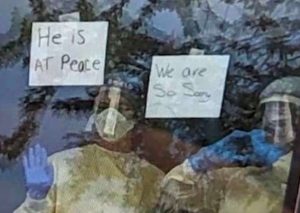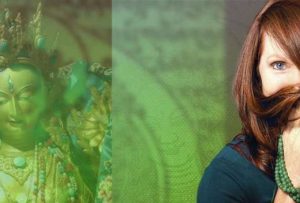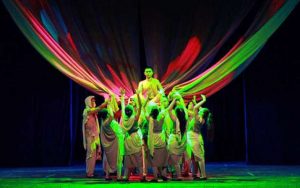
Women who could participate with elemental forces to uplift their consciousness, heal, convey divine instructions, and interpenetrate dimensions of psychic and physical reality have been called by different names in different cultures: priestess, nun, tigress, initiate, witch, sorceress, yogini, or miko, to name a few. Female energies appear as images in many world religions to assist in consciousness development and in moving between worlds: Buddhist dakinis, Celtic faeries, Biblical angels, Hindu apsaras, and Chinese feitian. Some of these have male counterparts. The introduction and priority of the female spiritual energy is what characterizes Buddhist and Hindu Tantra. In Tantra, the deities were joined by their equals: spiritual reflexes as female deities. Deity couples in sexual embrace, yab-yum, came to characterize Tantric Buddhist art.
This short series about female empowerment traditions has featured Buddhist nuns practicing Dakini Cham; Modern dancers doing authentic movement; Buddhist monks, nuns and lay people performing Chöd Cham, an act of psychic dismemberment; and Japanese Shinto miko, shrine priestesses, sustaining a dance tradition linked to earlier spirit possession practices. Today I have the pleasure to introduce Althea Northage-Orr, representing the Western esoteric tradition. She calls herself an elemental faery magician, meaning she works with elemental faeries, and in so doing, becomes one. (This is a parallel practice to Buddhist nuns doing Dakini cham.) The basic mechanism of mystical identity transfer is common to many traditions, including Buddhism, and so, it is not surprising that Althea—who is conversant in Eastern and Western esoteric practices of healing and meditation—speaks universally in a familiar mode of speech.

Althea is a most remarkable person, and totally down-to-earth. She’s a good friend to many and a teacher of Taoist neidan, which is internal alchemy, and of psycho-physical movement, a technique derived from the work of Moshe Feldenkrais. Althea is a Hermetic initiate and priestess since 1973. She served as director of the Chicago Hermetic Order for many years. She is a healer by profession, trained in traditional Chinese medicine, acupuncture, structural therapy, Bakti yoga, Aryuveda, Western and Chinese herbalism, and the whole-body systems that underpin these traditions. She understands and undertakes the role of a trance adept, or a goddess, or a priestess, in various Nature rituals. She teaches Kabbalah Tree of Life meditations, Taoist internal alchemy, the Microcosmic Orbit, Five Elements Theory, and when she offers a course on the history and development of Tarot, she’ll have dozens of students in a matter of days, using a set of Tarot cards she designed herself.
Althea grows all her own herbs in the country on a large property that hosts a Tree of Life garden comprised of individual shrines, a geodesic dome residence, and a replica of the Labyrinth at Chartres cathedral made with river rock. For some reason, the grasses and plants have never over-grown this labyrinth. . . in 35 years. She’s best known for her profound knowledge of the body-mind complex and for using this knowledge to heal people. She’s a gifted healer and a busy clinician. Most visitors to her lush property go home only after walking through the Chartres labyrinth. Althea is one of a kind—one of a legendary but not unknown kind. She is an elemental faery magician by her own description. She is wise, happy, and compassionate.

In 2009, the great scholarly expert on Taoist meditation, Livia Kohn, published an important book, Internal Alchemy: Self, Society, and the Quest for Immortality (Three Pines Press). It aspired to bring Taoist Internal Alchemy into a greater discussion of mind-body practices—including Indian Kundalini Yoga—and Western Hermeticism, two practical traditions with stunning parallels. There was one problem: she had a difficult time finding anyone who knew both Eastern and Western (Taoist, Tantric, and Hermetic) traditions. Fewer still knew how to do the practices. She was delighted to meet Althea, who authored the final chapter of Kohn’s book, titled “Western Parallels, the Esoteric Teachings of Hermeticism.”
Here is another testimony to Althea’s ethereal nature: she hardly has any good photos of herself. They all turn out like the Loch Ness monster, or Big Foot, or a Sylph. She is elusive to the camera. She’s very pretty, in the physical condition of someone decades younger, and as you might imagine, emanates a positive energy. She looks like a faery. She’s little and bright and flexible. . . and can do a lot of things most humans can’t do. I tell you: she exists. Links are provided below to her free weekly classes in Internal Alchemy on Mondays at 8 a.m., and Psycho-physical movement on Tuesdays at 8am. You can experience her for yourself. In this article, I’ll present schematics of the traditions she teaches and uses. For now, please enjoy these words from Althea, spoken for Buddhistdoor readers:
Part of why the Barbie film is so appealing is because she is an avatar to this other perfect world, and the film is about the interaction between the human world and this avatar-activated ideal world. This ability to move between dimensions of existence is a characteristic of Buddhist female dakinis and Celtic elementals. In fact, the realms interpenetrate. Interpenetrating life streams, of higher forces, of elemental forces, and of powerful evolutionary forces, are co-evolved by our interactions with them. Many practices of magic are formulae for interactions between humans and other spirit lifeforms.

People often treat the deity of the female entity—the characters, goddesses, and archetypes—as if they don’t have independent existence. They are independent entities that have a role in the evolution of the cosmos and our species. They are not creations of our mind. They are real. The elemental forces of our physical universe are not products of our imagination, even as we constantly discover new things about our world, and as these elemental forces are variously described in different cultures.
The practice of interacting with the elementals—the dance, if you will—continues to teach. Our interaction with other spiritual beings evolves. True of any lineage—the work teaches you; it begins leading you. You begin to discover things about yourself. These beings—it’s a vast array—I’m an elemental faery magician. We are enmeshed together: humans and other life streams, and live with them. All life streams are evolving together. Also true in a planetary cosmic sense. We need to be working with earth spirits and heavenly spirits.

A dakini—a visualized Buddhist meditation deity—is an image as well that you can draw on, to help your concentration and focus. Dakinis often dance, and dance means emptiness, so they become instructors of emptiness as well. In terms of my own experiences with various traditions – practices that make use of such divine images—what is important to emphasize is that we are interacting with actual beings. You can talk about authentic traditions, that’s fine, fabulous, they often have techniques, exercises, movements, and skills. The truth is: you just have to interact.
In Bakti Yoga, say you want to interact with one of these deities, Lakshmi for example. So, every day you get up. You have an image of Lakshmi you set up by your bedtable altar. You have a Lakshmi mantra that you recite every day, and you meditate, and you ask questions, and you take time to listen. Over time, what happens is: you move into resonance, with this being, Lakshmi, so abundance starts to come to you, you become more attractive, you come to attract certain energies. That is what Lakshmi is about.

In Bakti Yoga, what’s important with these ritual elements is the interaction with the being. If you meditate, recite, visualize, and ponder—you can be formal or not—you’ll begin to move into resonance with this being and you begin to take on its characteristics. Even with Christianity, if someone is taking on the attributes of Jesus. Which one? Jesus the Good Shepard, or Jesus the Final Judge? How we connect matters, it will determine the result. Angels, goddesses, highly developed beings—angelic magic is something I do. There are different types of angels. I am a faery magician, and I mostly interact with earth elementals, specifically plant elementals. I meditate with plants. I speak to them. They show themselves to me. I work with those beings.

Some people believe that George Washington Carver had a mystical relationship with plants. Of course, he did. Nature was spiritual to him. That is why he was such an innovator. Some people have a hard time thinking about interacting like this, because of their religious upbringing that did not see spirit within Nature. We all evolve together—we interact. Done consciously, it is better.
Magic is just one of these terms that we use when we are talking about working with energy in a way that is not obvious in the material sense. These days, people are materialists. Any physicist will tell you that reality is not at all what we see. Witches and magicians are people who work with these super-material energies, and generally are more focused on earth manifestation. There are traditions interested in celestial energies and connections to them. I am an earth faery. I was seeing the spirit world at a very young age, raised in a traditional Irish family. The Celtic tradition is to encourage imagination, not squelch it. I was able to enter into trance at a young age, and use sounds to induce different states of my own mind. It was natural to me, but I think it might have scared my mother!

There are many examples of religions absorbing the deeper teachings of the religion it replaced. Christianity has many pre-Christian elements within it—from the Chartres labyrinth to the perennial rebirth at the Winter solstice. This is natural. People sometimes ask if I think these beliefs and practices will die out. The answer is no. The beings are real, they will be here, and so the interaction with our human life stream will be too. Religion is perennial because of the life and reality of its elements, not because of our belief, which doesn’t make the elements real.
Hermeticism teaches—and this goes back to the Pharaoh Akhenaten in Egypt: observe the universal principles and practice the religion of the land. Otherwise, you will be burned at the stake. All is mind. From the renaissance, Hermeticism went through Gnosticism, and found its way into Sufism. Judaism is the purest form of Hermeticism. Kabbalah was sequestered in the heart of the religion, it really survived there. After complete training in Kabbalah, the secret is given: it is the Hebrew alphabet.

Hermeticism is a basic western version of a philosophy that you find at the heart of Vedanta; it’s the basis of Hinduism and Buddhism; it’s the way of Taoism. It’s non-dualistic. It starts with the notion of the universal mind, the All—whatever you want to call it—the ever-imminent impersonal energetic force which expresses itself through creation.
What is important—and at the heart of all real indigenous and mystical traditions—is that we are not separate from God. We are the universal mind knowing itself, the universe aware of itself. We are forgetting that we are the universal mind. That is the human condition. Mystics don’t accept this separation. For the mystic, they want to re-unite with the All. Mystics can re-connect and feel that connection. This is the path of the mystics, according to Kabbalah, directly up the middle of the Tree of Life.

The path of the magicians, which is the path of Nature, the right-hand path of the Tree, is this: to know by interacting with the elemental forces of nature, to allow them to flow through us and manifest reality and help it in its evolution.
Then there is the left-hand path of the Tree, the path of science, using knowledge and reason to learn and so assist evolution. Hermeticism expresses itself in all three paths: mystical, physical, and rational, just as there are parallel threads in Buddhism, Taoism, and other wisdom traditions. When you look at these sacred traditions, they are extraordinarily consistent worldwide in the basic things they are saying. Whether you are looking at shamanism, or at Buddhism or Taoism, or Hermeticism, they are pretty consistent.

They all believe that everything came from a universal energy, that then expresses itself through duality, and so on. They don’t posit some being “up there” judging what’s good and what’s bad. These wisdom traditions teach evolution. It’s no surprise that there is renewed interest in female empowerment traditions and spirituality at elemental, as well as mystical, levels. For the first time in history, the full menu is on display. Someone interested in exploring a wisdom tradition can choose from: Kabbalah, Wicca, Tantra, Hermeticism, Yoga, Taoism, Shinto Miko Mai, Buddhist chöd, Dakini Cham, Aryuveda, or Christian mysticism, to name some of the available teachings.
If someone is interested in pursuing some of these practices, it depends on what you are interested in. If you are interested in elementals, we could talk about earth, air, fire, and water; gnomes, and trolls; ondines, mer-people, zephyrs and sylphs; and other air beings. What are their forms? They don’t have forms. They are not material beings. They take on the form determined by our own cultural preferences and psychic comprehension. As the great Romantic ballet, La Sylphide, teaches us: don’t fall in love with one of them, it’s dangerous. You can learn to work with them. The writing is out there. I teach a practice called The Elemental Path. Each quarter you attune yourself to one of these elemental beings. This stuff is out there, it’s not secret, it’s not hidden.
Are you interested in deities? Find the one you most want to become. Get an image. Sit down. Talk to the being, it will talk back. Elementals are a little trickier. But you can appeal to these beings with small altars. You can build them a little house. In fact, building a small house for elemental deities, like Nagas—water spirits—is often part of a Himalayan healer’s prescription. These beings are powerful, and also enchanting, so unless you strengthen your mind, you will have some problems. It’s like anything else in life, really. These practices—even yoga and meditation—can be dangerous as they are cultivating aspects of the psyche and mind. You are playing with fire to be sure. Mysticism is a kind of craziness. Divine madness is real. Tantrikas don’t “meet” each other, they “recognize” each other. I’m 71, I’ve been doing these practices, East and West, all my life and I’m OK.

Working with these realms directly has its risks and has enormous benefits. Find a good teacher and if not, keep asking for help along the way. You can evoke whatever your concept of god or your angel is. There is no way to do this work if you are not prepared to be stretched, challenged, dumped in the abyss, pulled back up, dismembered, and re-assembled. . . that is what this work is. The benefit is: you grow. This is an evolving process. I’m a little out there, I don’t mind being possessed, dancing around, serving a role in a ritual. Having all these formerly secret transmissions now available, doesn’t change the fact the only people who respond to the great mysteries are those called to it, inclined to it.
Most secrets are open secrets. “We are deeply connected to all nature!” That’s hardly a secret. But who can do magic with that? People should educate themselves and realize, that these are real powers. It is an opening up to realize that starting point.”
~
This concludes my series, Faeries, Dakinis, Nuns, and Mikos. I want to thank the four women featured for sharing their extraordinary lives and work: Lindsay Gilmour, Karen Greenspan, Elizabeth Tinsley, and Althea Northage-Orr.
See more
Taoist Neidan class, Mondays 8am CST. Free. (Zoom)
Psycho-physical movement class, Tuesdays, 8am CST. Free. (Zoom)
Related features from BDG
Faeries, Dakinis, Nuns, and Mikos, Part Three
Faeries, Dakinis, Nuns, and Mikos, Part Two
Faeries, Dakinis, Nuns, and Mikos, Part One












